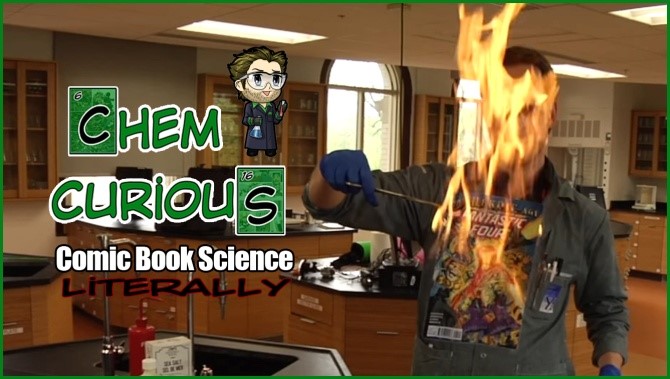Introduction
Superhero movies have grossed over a billion dollars worldwide in the last year, and the adaptation of comic book characters for TV shows has grown exponentially, reaching out to a wide audience of scientific admirers, young and old, as well as to new science inquirers. Science has infused legends while numerous sagas have stirred scientific curiosity. Together they have evolved as science fiction, and the science in fiction can be used to engage students. Since shaping teaching into story-telling can make knowledge more meaningful, using superheroes to teach chemistry is an attention-grabbing device that helps to connect with students. Many superheroes by night are scientists by day, such as Barry Allen (aka The Flash), Bruce Banner (aka The Hulk), and Tony Stark (aka Iron Man) who have spent numerous hours studying and working in the laboratory, respectively, as chemist, physicist and engineer. After all, their understanding of science is their true super power.

Since 2013 a complementary chemistry course for non-science students has been offered at Dawson College. Entitled Comic Book Chemistry, the course content uses chemical evidence to analyse certain super powers, innovative armours and marvellous abilities of characters seen in movies, TV shows and graphic novels. Given the course’s particular subject matter, and no scheduled laboratory period, bringing chemical experiments to the students seemed essential to capture the essence of this experimental field. Since videos offer a safe, easy and reproducible way to show students complicated experiments (both in and out of class), the production of short experimental videos was investigated. Videos seemed a practical medium to convey information and engage a generation that has grown up in the digital era.
Can Pop Culture be Used to Transfer Knowledge?
Most students nowadays can tell you the names of the four most inspiring artists of the Renaissance, not necessarily because they studied art, but because they can link this knowledge to comic book characters. The fictional team members of the Teenage Mutant Ninja Turtles (TMNT) are four heroes named Leonardo, Raphael, Donatello and Michelangelo, and these names are pretty much the only thing they share with the famous Italian artists. Because students know the names of the comic book protagonists, they will also remember the names of the artists for the rest of their lives.
In science, the character of Walter White in the HBO TV series Breaking Bad went by the alter-ego of Heisenberg. The Heisenberg Uncertainty Principle, stipulated by the 1932 Nobel Prize-winner Werner Karl Heisenberg, states that the position and the velocity of an object cannot both be measured exactly, at the same time. The principle is hard for most students to grasp when it relates to electrons, but because students can relate to the character, the name itself is no longer unknown, and an analogy can be attempted to solidify its meaning. In the TV show, the police know how fast Heisenberg is moving the drugs, but they don’t know where to find him or the crystal methamphetamine. A name associated with a fictional character makes reality easier to comprehend.
How do Superhero Movies Help Students Learn About Chemistry?
Iconic heroes perform incredible stunts that, to a certain extent, can be made credible by using science. Spider-Man is the most popular hero in the Marvel Comics Universe (MCU) and has the ability, as seen in the movie Spider-Man (2002), to climb vertical walls using only the hair on his hands. Humans cannot perform this prowess without the help of adhesive, suction cups or other equipment. On the other hand, geckos can quickly turn the stickiness of their feet on and off. They can stick to surfaces because their bulbous toes are covered with hundreds of tiny microscopic hairs called setae. Each seta splits off into hundreds of even smaller bristles called spatulae. The tufts of tiny hairs get so close to the contours in walls and ceilings that the van der Waals force kicks in. This type of physical bond happens when electrons from the gecko hair molecules and electrons from the wall molecules interact with each other and create an electromagnetic attraction.[1]
The weak but present Van der Waals intermolecular force is an extremely important concept taught to first-year General Chemistry students, and is too often misunderstood. Relating it to the tiny hairs that grow on Spider-Man’s fingers quickly conveys the basic idea with a macroscopic application. This principle can be further illustrated by using two Spider-Man omnibuses (or big chemistry books) and interlacing the pages from each book, one on top of the other. Once assembled without the help of any glue, it will be impossible to pull apart the two books because of the van der Waal force holding them tightly together. Using the same principle, gecko gloves have been created to climb walls, and are now being sold online. Having students discuss other practical applications mimicking superhero behaviour is another way to get them thinking about intermolecular forces.
Within just a few minutes, entertainment can be transformed into an educational moment (also known as Edutainment). The obvious next step was to prepare short videos, tailored to the classroom needs, combining a movie clip and chemical explanation, followed by a laboratory demonstration.
Chem Curious: Pop Culture Laboratory Videos
With the support of the Dawson College chemistry department, the help of the chemistry laboratory technicians, financial support from the SALTISE mini-grant program,[2] and the camera expertise of a student in the Cinema-Communications department, a series of seven short educational videos was put together in 2015. Freely hosted on the CHEM CURIOUS YouTube channel,[3] they were regrouped in the playlist titled Chem Curious POP Culture Edition.[4]
Each video starts with a clip from a popular movie depicting an extraordinary feature performed by a protagonist. This is followed by a list of common chemicals used to replicate the trick in the laboratory, and, of course, the demonstration of the chemical experiment. For more information on how to make videos destined to the classroom and the thinking that goes into the preparation of a video, please refer to the approach written by professors from Vanier, John Abbott and Dawson colleges.[5] Given that “a picture is worth a thousand words,” imagine the impressive amount of information that is conveyed in 30 “pictures” per second.
Spider-Man Parallels
Teaching about polymeric condensation reactions by referring only to chemical structures in a textbook can be dull for some students (figure 1). On the other hand, once again linking the transformation of matter to the most famous web-slinger may raise class interest.
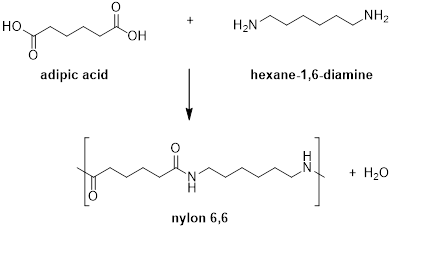 Figure 1. Synthesis of nylon 6,6.
Figure 1. Synthesis of nylon 6,6.
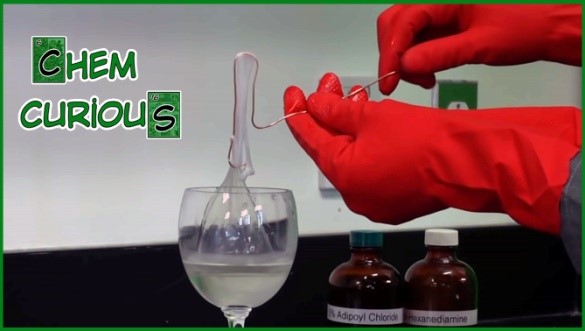
The fictional character of Spider-Man has the ability to create a long and strong rope on demand that is being shot from a concoction on his wrists, as seen in the movie Amazing Spider-Man (2012). The most popular video on the channel (Spider-Man Webbing, over a million views) demonstrates that when the two liquids (adipic acid and hexane-1,6-diamine) come in contact, they form a solid (nylon). Furthermore, since this solid forms only at the interface of the immiscible liquids (liquids not forming a homogeneous mixture), it can be pulled out of the mixture and reformed, creating a very long and strong nylon string. The video ends by putting each reactant in a water gun and aiming both of them at the same surface to synthesize a nylon patch. The reaction is the same, but the outcome is macroscopically different, still mimicking the web-shooter’s ability. This demonstration shows students a chemical reaction that produces a substance they know and does so in a way that triggers their imagination. Engaging students to consider structural variations of the polymer synthesis to create, for example, bulletproof Kevlar or stretchy spandex, can be done in or outside of class.
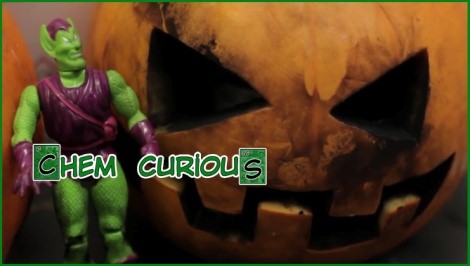 Using Spider-Man’s foe as a mean to solve practice problems in chemistry has also been introduced using Chem Curious videos. The Green Goblin villain uses his signature pumpkin-bombs to cause mayhem in the form of small explosions. Using another video depicting the synthesis of acetylene gas as well as its combustion (figure 2) inside a small pumpkin demonstrates an explosive real-life application of chemical reactions. Chemistry students often struggle with calculations involving gas stoichiometry (the relationship between the relative quantities of substances taking part in a reaction) and ideal gas law concepts. After watching the video (SPIDER-MAN Villain: GREEN GOBLIN Pumpkin Bomb), students get a better sense of proportions and hence “crunching numbers” is not perceived as abstract. By modifying the quantities of reagents and having students do the calculations on paper (or in teams on writable surfaces), the instructor can measure students’ understanding of limiting reagents, for the same reactions.
Using Spider-Man’s foe as a mean to solve practice problems in chemistry has also been introduced using Chem Curious videos. The Green Goblin villain uses his signature pumpkin-bombs to cause mayhem in the form of small explosions. Using another video depicting the synthesis of acetylene gas as well as its combustion (figure 2) inside a small pumpkin demonstrates an explosive real-life application of chemical reactions. Chemistry students often struggle with calculations involving gas stoichiometry (the relationship between the relative quantities of substances taking part in a reaction) and ideal gas law concepts. After watching the video (SPIDER-MAN Villain: GREEN GOBLIN Pumpkin Bomb), students get a better sense of proportions and hence “crunching numbers” is not perceived as abstract. By modifying the quantities of reagents and having students do the calculations on paper (or in teams on writable surfaces), the instructor can measure students’ understanding of limiting reagents, for the same reactions.
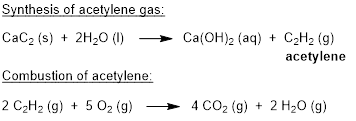
Figure 2. Example of gas synthesis and combustion
Other Characters
The Chem Curious videos received very positive feedback, both from students and worldwide viewers. Since the first series of videos in 2015, three additional seasons of POP culture videos have been created,[6],[7],[8] and a fifth season will be uploaded over the course of the fall 2019 semester.
Videos of multiple characters may be selected to introduce basic chemistry concepts. For example, while the electron transfer of dissolved metals in solution might be intangible for some, looking at ionic metals quickly precipitating out of an aqueous solution in the hands of a hero makes a redox reaction more concrete. Using the transformation of Colossus, a metal-skinned hero, to demonstrate how silver ions interact with copper to replace a solid in solution, renders the oxidation-reduction concept more accessible. In a similar manner, videos on Iceman’s instant freezing touch or the formation of a blue Jedi cavern can serve as examples of crystallization.
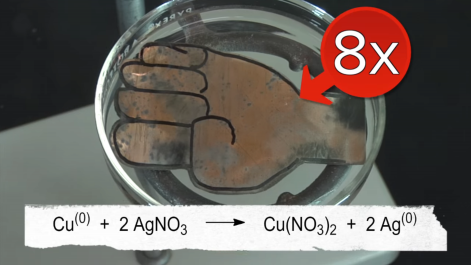 |
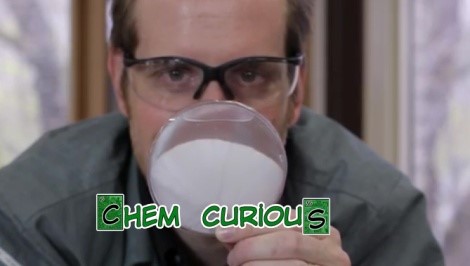 |
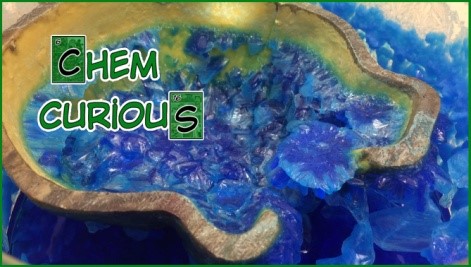 |
Comments from students guided the direction of the growing pool of videos, and experiments using household chemicals easily reproducible at home were gathering more interest. Among the favourites, the creation of plasma – re-creating Iron Man’s energy source – only needed a microwave oven, a match and an upside down Pyrex container. Of course, spitting fire like the Ghost Rider or spinning fire like Doctor Strange’s portals are always mesmerizing when performed cautiously. Mimicking Venom’s symbiote by creating magnetic black slime using iron oxide powder, is a safer experiment that can be done with children.
Colourful changes, vivid flames and rapid phase transfer instantly catch the attention of the viewer. Some of the experiments were even integrated in the annual Dawson Open-House magic chemistry show, such as the Invisible Woman Refractive Index, the Pyro’s flaming hand and the Fantastic Four Fire Tower.
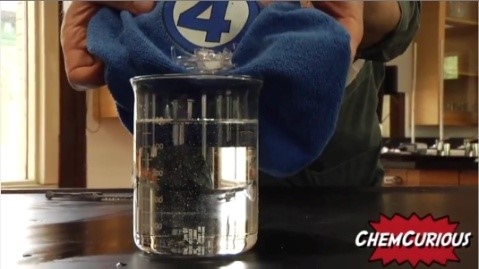 |
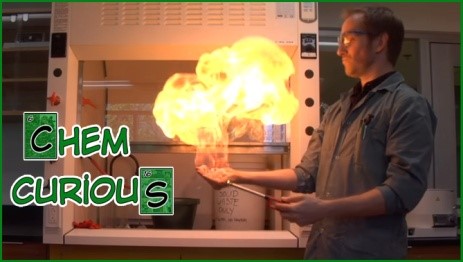 |
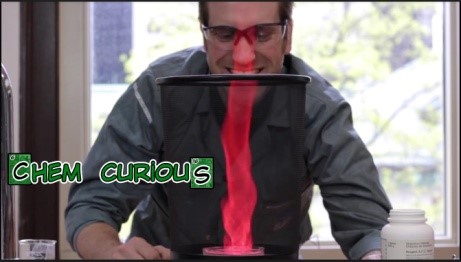 |
Comic Book Science Literally!
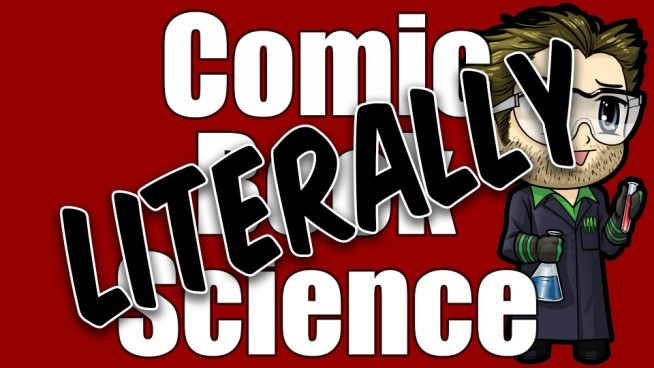 Playing around with comic book themes and chemistry eventually led to the idea of performing experiments actually using a comic book. Answering questions such as “Is paper electrically conductive?,” “How strong is a single sheet of paper?” or “Can a comic book or its protective sleeve be inflammable?” were tackled and regrouped under a series called Comic Book Science Literally!
Playing around with comic book themes and chemistry eventually led to the idea of performing experiments actually using a comic book. Answering questions such as “Is paper electrically conductive?,” “How strong is a single sheet of paper?” or “Can a comic book or its protective sleeve be inflammable?” were tackled and regrouped under a series called Comic Book Science Literally!
The overall idea is for students and viewers to realize that chemistry is everywhere. It surrounds us and is part of us. Chemical changes occur not only in the lab but in every aspect of our lives. The word chemistry should not generate fear but should inspire and be fun for all.
Conclusion
The addition of Arts to the STEM curriculum via videos can foster student inquiry, dialogue and critical thinking. Chemistry themes inspired by fictional icons provide students with a relatable introduction to complex concepts and trigger dynamic discussions for learning.[9],[10],[11],[12] Super powers offer a vast pool of cases that can be demystified using scientific evidence. After all, if knowledge is power, teachers can be superheroes!
The pool of Chem Curious videos is constantly growing, with ten new videos added every year. If you have an idea, or wish to help out, do not hesitate to contact Yann Brouillette.
Endnotes
[1] Kelly Dickerson, Geckos’ Sticky Secret? They Hang by Toe Hairs, Live Science, August 12, 2014.
[3] YouTube channel CHEM CURIOUS.
[4] CHEM CURIOUS Pop Culture Edition Season 1 – Playlist 2015.
[5] C. Cormier, E. Awad, Y. Brouillette, V. Turcotte, Planifier, réaliser et diffuser des vidéos éducatives : lignes directrices et astuces pour les enseignants, Profweb, Dossier, 19 septembre 2017.
[6] CHEM CURIOUS Pop Culture Edition Season 2 – Playlist 2016.
[7] CHEM CURIOUS Pop Culture Edition Season 3 – Playlist 2017.
[8] CHEM CURIOUS Pop Culture Edition Season 4 – Playlist 2018.
[9] Y. Brouillette and W.D. Lubell, The Molecular Marvels of Thor, Chemistry Views Magazine, 2019.
[10] Y. Brouillette and W.D. Lubell, The Molecular Marvels of Captain America, Chemistry Views Magazine, 2018.
[11] Y. Brouillette, Comic Book Chemistry: Teaching Science Using Super Heroes, CIRCE Magazine STEAM Edition 2019, 1, 47-58.
[12] Y. Brouillette and W.D. Lubell, Chemistry in the Comics: Molecular Marvels of Iron Man, School Science Review 2019, 373 (100), 48-57.


